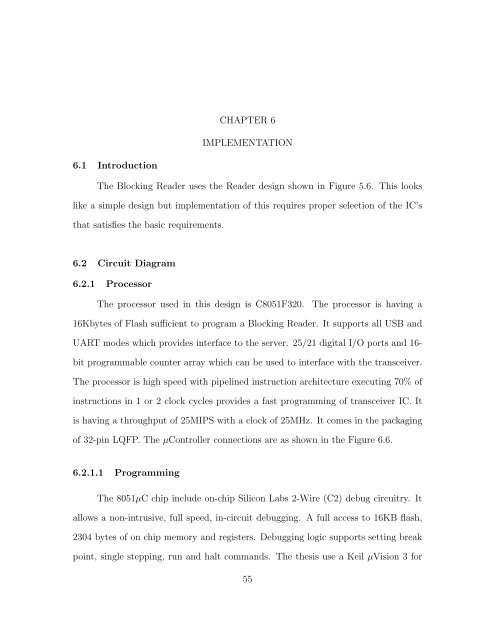BLOCKING READER: DESIGN AND IMPLEMENTATION OF A ...
BLOCKING READER: DESIGN AND IMPLEMENTATION OF A ...
BLOCKING READER: DESIGN AND IMPLEMENTATION OF A ...
You also want an ePaper? Increase the reach of your titles
YUMPU automatically turns print PDFs into web optimized ePapers that Google loves.
6.1 Introduction<br />
CHAPTER 6<br />
<strong>IMPLEMENTATION</strong><br />
The Blocking Reader uses the Reader design shown in Figure 5.6. This looks<br />
like a simple design but implementation of this requires proper selection of the IC’s<br />
that satisfies the basic requirements.<br />
6.2 Circuit Diagram<br />
6.2.1 Processor<br />
The processor used in this design is C8051F320. The processor is having a<br />
16Kbytes of Flash sufficient to program a Blocking Reader. It supports all USB and<br />
UART modes which provides interface to the server. 25/21 digital I/O ports and 16-<br />
bit programmable counter array which can be used to interface with the transceiver.<br />
The processor is high speed with pipelined instruction architecture executing 70% of<br />
instructions in 1 or 2 clock cycles provides a fast programming of transceiver IC. It<br />
is having a throughput of 25MIPS with a clock of 25MHz. It comes in the packaging<br />
of 32-pin LQFP. The µController connections are as shown in the Figure 6.6.<br />
6.2.1.1 Programming<br />
The 8051µC chip include on-chip Silicon Labs 2-Wire (C2) debug circuitry. It<br />
allows a non-intrusive, full speed, in-circuit debugging. A full access to 16KB flash,<br />
2304 bytes of on chip memory and registers. Debugging logic supports setting break<br />
point, single stepping, run and halt commands. The thesis use a Keil µVision 3 for<br />
55
















